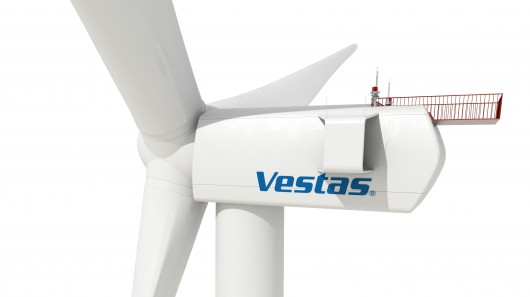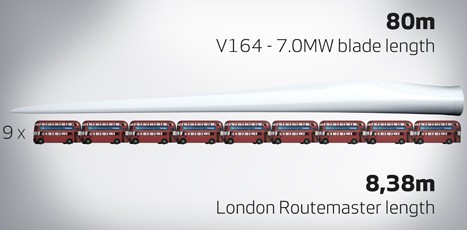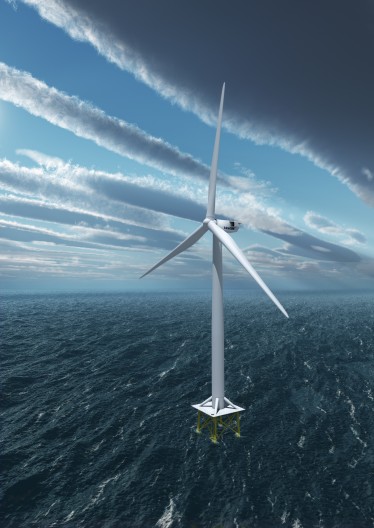Vestas launches design for world's largest offshore wind turbine
22:31 April 6, 2011

Vestas has revealed plans to build the largest dedicated offshore wind turbine in the world - the 164 m diameter V164
Offshore wind power specialist Vestas has revealed plans to build the largest dedicated offshore wind turbine in the world. The proposed V164 would have a 7.0 MW capacity, twice that of its predecessor, the 3.0 MW V112. The awesome 164 meter (538 ft) diameter rotor would eclipse the size of the current titleholder, the prototype G10X installed by Gamesa in Spain in 2009 which has a diameter of 128 m (420 ft).
The world's largest capacity wind turbine, the Enercon E-126 has a rated capacity of 7.58 MW, but its 126 m (413 ft) diameter would still be dwarfed by the V164. The proposed Sway AS rotor diameter of 145m (476ft) and could stretch capacity to 10 MW.
Vestas V164-7.0MW has a blade length of 80 meters, the length of nine routemaster buses
Horizontal-axis wind turbines (HAWT) are designed with a rotor shaft and electrical generator at the top of a tower. Small turbines are pointed into the wind by a simple wind vane, while large turbines generally use a wind sensor coupled with a servo motor. Most have a gearbox, which turns the slow rotation of the blades into a quicker rotation that is more suitable to drive an electrical generator.
Vestas approached the design using two separate R&D teams – one investigating direct drive, and one investigating geared-train turbines – and eventually a proven medium-speed drive-train solution was chosen.
Vestas' V164 has been specially designed to withstand the punishing North Sea winds and the business case is aimed at the European market, especially the North European countries of UK, France, Sweden and Germany among others.
Construction of the first V164-7.0 MW prototypes are expected in late 2012, with serial production set to begin in early 2015 if enough orders are received to justify the substantial investment needed. Vestas says that the energy taken to produce the turbine would be paid back within ten months of installation.
Wind power in perspective
In the EU in 2009 renewable energy and wind accounted for 7% and 2% respectively of energy production, compared with coal at nearly 25%. Governments have agreed to increase energy production to 13% from renewable sources by 2020.
The potential added capacity of renewable energy in the EU accounts for two thirds the capacity available for all energy sources, and Vesta hopes to make wind the driving force behind the move towards 10% energy from wind by 2020.
"Seeing the positive indications from governments worldwide, and especially from the UK, to increase the utilization of wind energy is indeed very promising. We look forward to this new turbine doing its part in making these political targets a reality," said Vestas CEO Ditlev Engel.
Copyright © gizmag 2003 - 2010 To subscribe or visit go to: http://www.gizmag.com

